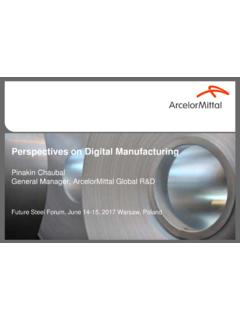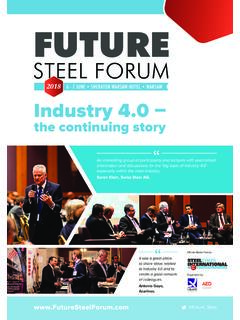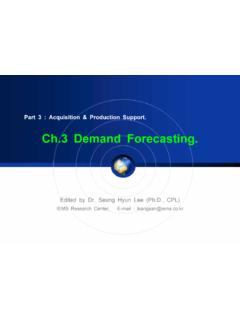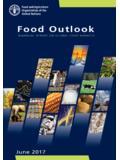Transcription of Industry 4.0 in Steel: Status, Strategy, Roadmap and ...
1 14th June 2017. Industry in Steel: status , strategy , Roadmap and capabilities Keynote Presentation Future Steel Forum, Warsaw Dr. Nils Naujok, Holger Stamm The steel Industry is facing significant challenges due to cost, regulatory, product and service requirements Metals business challenges Shift from commodity steel towards heterogeneous product portfolio Applications towards stronger and more durable steel Product requirements Shorter product-life-cycles in downstream business Increased exports from China as well as stagnating Chinese economy Lower demand from Russia due to weak currency and sanctions Cost pressure Increasing overcapacity in European plants Slowed down market growth at only 1,8% CAGR in Europe results in weakened demand Shorter innovation cycles down-stream and increased share in project-based business urge flexible use of capacity and reliable delivery of products Process complexity and Heterogonous product portfolio and small batch size in special steel need to be optimized (focus on service requirements service and flexibility).
2 Ambitious CO2 regulations boost certificate trading and cause additional costs Sustainability efforts in downstream business Regulatory requirements Efficient use of resources and energy PwC's Digital Services 2. Future Steel Forum, Warsaw Metals CEOs plan for growth fueled by efficiency, innovation and digitization Metals CEOs are looking to drive growth organically through cost reduction and investment in innovation Which of the following activities, if any, are CEOs planning in the To what extent has technology changes competition in your coming twelve months in order to drive corporate growth or profitability? Industry over Organic growth 78%. Past 5 years Cost reduction 69%. New M&A 31%. Next 5 years New strategic alliance / JV 28%. Outsourcing 28% 60% 40% 20% 0% 20% 40% 60% 80%. No impact Moderate impact Significant impact Complete reshaped Which one of the following do CEO's most want to strengthen to 59% of Metals CEOs think that technology will be game changer for the capitalize on new opportunities?
3 Industry and will reshape competition over the next five years. We see significant potential in the digitization of processes in the supply Innovation 25% chain, production, sales & marketing and administration. In volatile business environments with demanding customers, digitization Competitive advantage 19%. provides more agility in asset-intensive industries like metals and enables Customer experience 13% significant differentiation. While digitization requires a significant portion of capital expenditure, it's Cost containment 13% fundamental to company strategy and a sustained competitive advantage Human capital 13% in the future. PwC's Digital Services Base: All respondents (Metals, 37) 3. Future Steel Forum, Warsaw Source: PwC 20the annual Global CEO survey: Key findings from the global Metals sector (2017). Industry featuring the digital enterprise combines vertical and horizontal integration with customer access & business models Mobile devices Digital Enablers Cloud computing IoT platforms Augmented Location detection Open Innovation reality/wearables technologies Industry Advanced Digital Enterprise Automated Guided human-machine Vehicles / Drones interfaces IT Architecture and Data Authentication &.
4 Management Big data analytics fraud detection and advanced algorithms Compliance, Security, 3D printing Legal & Tax Smart sensors PwC's Digital Services 16. Future Steel Forum, Warsaw From talk to action Industry is moving from strategic hype to operational reality High Level of digitization and integration today High level of digitization by operational function and in the next five years Vertical value chain 41%. integration 72%. Horizontal value chain 34%. integration 65%. 33% +39% 72% Digital business models, product and service portfolio 29%. 64%. Product development & 42%. engineering 71%. Customer access/ 35%. High level of High level of Channels & marketing 68%. digitization today digitization in 5 years Today In 5 years Percentage of companies reporting high degrees of digitization and integration today/in five years for selected operational functions Shown: Percentage of companies surveyed reporting high degrees of digitization and integration (4 or 5 on a scale of 1 very low to 5 very advanced ).
5 Source: PwC strategy & Global Industry Survey 2016. PwC's Digital Services 5. Future Steel Forum, Warsaw Fundamental business model transformation follows five key trends Business model transformation Drivers Strong focus of management board strategy : I becomes strategically important to High value add (product mix, costs, inventories). generate competitive advantages Pressing customer demand (Auto) and economics Focus on production: Energy, Yield, Quality SEQUENCE: The horizontal integration with customers Then: New service and business models for MRO, supply chain builds vertical process management. management and steel service centers Successful development of big data and sensor tech. CAPABILITY: Steel producers will further control the Closeness of physical and business processes steel making process and know-how. Risk: Cyber Security, Ownership of IP. 1. wave: process automation within MRO. Roadmap : I is driven via integrated roadmaps with 2.
6 Wave: SC Integration with Tracking, QM, R&D. multiple waves across functions Continuously: Analytic capabilities , business case Customer and value add processes INTEGRATION: I leads to the integration of Breakup of barriers: functions and business processes, organization and reduced barriers Aligned and value driven steering models PwC's Digital Services 6. Future Steel Forum, Warsaw First use cases for wave one processes are constituting . Digitalization revolutionizes the steel Industry Use Cases Wave 1: 1. Vertical Integration Improve quality and efficiency of steel Asset production via Data & Analytics configuration Production Resource 2. availability Improve maintenance productivity via Mainte- nance high-precision Tracking Systems Suppliers Process quality Metals 3. Business data Product quality Increase facility transparency, quality Maintenance and efficiency via Drones Customers Management Quality Sensor/ actuator 4.
7 Logistics mgmt. Advance price and quantity forecasting data and via Predictive Analytics inventory 5. Wave 2: Horizontal Integration 3D printing solutions for spare parts E2E Location / Quality Inventory Customer Supplier network track & informa- levels demand capacity trace tion Source: Fraunhofer IAIS (2015), strategy &. PwC's Digital Services 7. Future Steel Forum, Warsaw Sensor Data Process Data Temperature Scrap mix Using available sensor, process and quality Voltage Nickel alloy share data for the steering of the electric arc furnace Amperage Melting time at client's site Pressure Cooling time Optimize process efficiency and costs Increase product quality Get real-time transparency on current product conditions Chemical composition Steel strength Quality Data PwC's Digital Services 8. Future Steel Forum, Warsaw Digitally enhanced industrial maintenance Sensor data Remote Predictive collection control center maintenance Predictive analysis improves price and quantity forecasting Use of data & analytics to predict maintenance and repair situations Optimize maintenance and repair cycle due to optimized planning and real time alerts Remote, dynamic monitoring machines conditions OEMs to expand from Leading steel player leverages Industry to consolidate and analyze data allowing product into service business predictive maintenance & remote support PwC's Digital Services 9.
8 Future Steel Forum, Warsaw WORKSHOP CLIENT EXAMPLE. Improve maintenance people and work shop tracked Technician productivity through traceability: Asset Improve work shop layout 04. and area occupation Asset 08. Improve utilizations by adapting tracking results Asset Asset into routines 12 05. Asset Optimize routings and 08. navigation to assets, tools and spare parts Reduce unnecessary idle /. waiting times and pathways Accelerate repair duration PwC's Digital Services 10. Future Steel Forum, Warsaw CLIENT EXAMPLE. Drone technology to increase stock transparency and facility efficiency : Facilitate measurements of difficult to access objects &. mitigate risky operation Decrease time and costs for inspection procedures Avoid process interruptions by real-time structural fracture identification Speed-up measurement of arrived bulky stocks Quality / speed of stock and volume inspection PwC's Digital Services 11. Future Steel Forum, Warsaw For the forecast.
9 The individual drivers are simultaneously predicted into the future by and through . ARIMA-Models MReg-Models Benefit: VAR-Models Combination of econometric Neural Networks models with expert knowledge . Advanced price and quantity forecasting: Use a broad range of driver and input factors Automate relevant drivers and tested / used in the explanation model selection and optimized Time lags Forecast explanation model creation Historical Apply advanced forecast Prediction Data modelling technics like Econometric Regression or Today Neuronal Networks Recognizes changes within the drivers adapt machine learning techniques PwC's Digital Services 12. Future Steel Forum, Warsaw Simplification through 3D printing Traditional way Supply Chain Production Delivery Support 3D printing revolu- tionizes spare part ~50 parts shipped in Production offshore Multi-stage Shipped in from from different places in low-cost location delivery large inventory business Innovative 3D printing tech- nology to print spare parts Supply Chain Production Delivery Support Manufacturing of strong.
10 Light 3D Printing parts while reducing pro- duction time and cost On demand replication of 5 components/ Production near Local van delivery Printed on demand spare parts materials shipped in customer and delivered same day Short-term delivery enables significant reduction in spare Local and quick Reduced inventory Benefits Simplified supply Lower labor units parts inventory chain fewer and transport cost delivery cost suppliers Infrastructure not bound to No need to follow Low cost and fast cheap labor rates delivery production facilities PwC's Digital Services 13. Future Steel Forum, Warsaw Industry and Digital capabilities develop across six dimensions and four stages PwC strategy & Digital Maturity Assessment I Digital Novice II Vertical Integrator III Horizontal Collaborator IV Digital Champion First digital solutions and isolated Digital product and service Integrated customer solutions Development of new disruptive Digital products & services applications portfolio with software, network across supply chain boundaries, business models with (M2M) and data as key collaboration with external innovative product and service differentiator partners portfolio, lot size 1.









